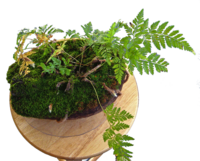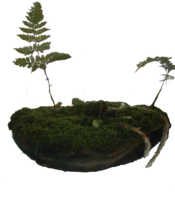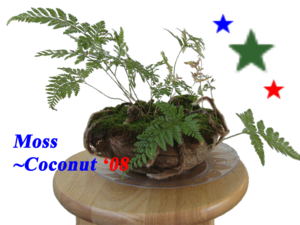Mossy coconut
Mossy coconuts are a remarkably versatile waste of space. Lauded by at least one professional decorator as "completely useless, but still kind of nifty," the mossy coconut is... mossy. It has moss growing on it, you know?
They can be placed almost anywhere around the home, requiring only water and shade from the sun. The horrible, blistering, scorching sun.
Origins[edit]
Evolution invented the mossy coconut circa 1026 BCE, as a direct result of the Norman conquests. No, wait, that's not right. The mossy coconut evolved via convergent evolution, when an unfortunate coconut got split in half and some moss spores got inside.[1] Evolutionarily speaking, the moss proved to be perfectly suited to living inside a coconut. The shell held dirt and water, and the coconut's flesh was delicious. Coconut-fried shrimp would have been even better, but moss is not picky. With the moss and coconut fused into a single, symbiotic organism, it now had to find a niche in which it would thrive. The endtables of suburban ninnies living in a consumerist society would prove to be the perfect environment, but humans would have to find them first.
Humans first began using mossy coconuts when they realized that they could be used as absolutely nothing of importance. This probably happened right after the Norman conquests... whoops, just kidding. What really happened was this guy named Dane Earl Johnson, Jr. saw a mossy coconut lying innocently in the shade of a palm tree. Being a bit of a screwball, Johnson decided he could make his fortune by cultivating and selling mossy coconuts to gullible suckers all over the world. He was horribly mistaken.
Mistaken, that is, in assuming only gullible suckers would want to buy these funky little conversation pieces. Everybody wanted to get their hands on one.
Significance[edit]
Because it was the Seventies, people everywhere were clamoring for mossy coconuts. This mass hysteria is generally known among social psychologists as "one of the dumbest things humanity has ever come up with." Regardless, Dane Earl Johnson, Jr. was making a killing selling these things; mossy coconuts were bigger than Furby. People were lining up for these things.[2] How did Johnson do it?
The Sales Pitch[edit]
Johnson's success in selling the coconuts is largely attributed to his unique sales pitch. He would often comment to prospective customers: "This one's been growing for almost a year now." The humble coconut was elevated to new heights[3] by this seemingly casual remark.
"Wow," people would think, "a whole year! I would never have the patience to do that myself." Yes, by growing the mossy coconuts for a year before selling them, Johnson saved his customers the trouble of growing their own. This was a hugely popular marketing tactic; people were overjoyed by the fact that they could get their mossy coconuts when they were ripe, instead of growing their own. It didn't matter that no one had ever thought of owning a mossy coconut before, much less even put the two words together in the same sentence. It mattered even less that people neither needed nor particularly wanted such a thing, because the important thing was that it was now more convenient than ever before.
Uses[edit]
None.
sometimes people use them as bras> Maybe even a bowl.
Health Benefits[edit]
None.
Tax Deductibility[edit]
None Very little.
Development[edit]
The mossy coconut has changed over time, as all things must. None of these changes have made it any more useful. The greatest change in the mossy coconut occurred during the Norman conquests.[4]
The Ferns Dane Earl Johnson, Jr. decided the mossy coconut needed more than just moss; it needed something a little more vascular. Rather than growing something useful, like tomatoes or cannabis, the tradition of the mossy coconut was preserved by putting ferns in with the moss. This helped make the coconut look more like a houseplant and less like something from the back of the refrigerator. Still, the ferns didn't actually do anything, existing only to take up space and disposable income.
Freaky Tarantula-leg Things For no reason whatsoever, strange furry growths started appearing on the mossy coconuts. Long, tough, fuzzy little things called "rabbit's feet" grow all over it, and when you look at it from the side it looks like some kind of weird, twisted tarantula. Still, they don't do anything practical that might warrant keeping it in or around the house.[5]
Legacy[edit]
Being an inanimate object, the mossy coconut has no real legacy of its own. The poster on the left advertises the mossy coconut's supposed run for U.S. President in 2008, but it was actually a simple hoax perpetrated by people who were particularly infatuated with their moss-covered conversation pieces. To its credit, the mossy coconut would be the most libertarian president the United States has ever had, since it would not, technically, get involved in the people's personal lives. Unfortunately, there is no distinct "Libertarian" party in the U.S., which would have made it difficult to secure a voter base, had it actually run for president. Which it didn't, you silly person.
What to do with a Mossy Coconut[edit]
There isn't much you can do with a mossy coconut, which you probably gathered from the sections above. Owners of mossy coconuts typically place them wherever they need space filled up with something inane. Looking at the mossy coconut is another common activity, but since it requires shade (lest the moss dry out) it is almost always seen in dim light, and thus not all that nice to look at.
Some owners claim watering the mossy coconut is the most entertaining part of caring for a mossy coconut, although it really only requires a few spritzes of clean water from a spray bottle once or twice a day. One can refill the spray bottle for extra entertainment.
Footnotes[edit]
- ↑ Moss seeds are called spores, right? I forget.
- ↑ Lining up, not 'queuing'. We're talking about the USA here.
- ↑ About six and a half centimeters.
- ↑ This is the last one, I swear.
- ↑ Actually, the ferns and the rabbit's feet are parts of the same plant. Everything you just read has no purpose other than to waste space, like a mossy coconut.



